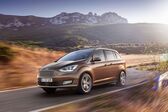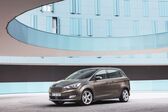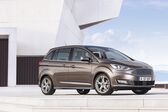Car Specs Ford C-MAX Grand C-MAX (facelift 2015) 1.0 EcoBoost (100 Hp) S&S 7 Seat
Ford Grand C-MAX (facelift 2015) 1.0 EcoBoost (100 Hp) S&S 7 Seat Specs
Ford Grand C-MAX (facelift 2015) 1.0 EcoBoost (100 Hp) S&S 7 Seat has been in production since 2015 - present. Cars comes in MPV body types and can be suited with Petrol (Gasoline) engine types with a volume of 1L liters, engines produces a power of 100 Hp. Fuel consumption of Ford Grand C-MAX (facelift 2015) 1.0 EcoBoost (100 Hp) S&S 7 Seat is 5.2 l/100 km. The overall dimensions of the car are 4519x1828x1684 mm, and the weight is from 1493 kg.
General data Generation Grand C-MAX (facelift 2015) Modification 1.0 EcoBoost (100 Hp) S&S 7 Seat Start of production 2015 year Powertrain Architecture Internal Combustion engine Body type MPV Seats 7 Doors 5 Fuel Type Petrol (Gasoline) Fuel consumption (economy), emissions Fuel consumption - urban 6.4 l/100 km Fuel consumption - extra urban 4.6 l/100 km Fuel consumption - combined 5.2 l/100 km CO2 emissions 119 g/km Emission standard Euro 6 Performance specs Acceleration 0 - 100 km/h (0 - 62 mph) 13.7 sec Maximum speed 172 km/h Weight-to-power ratio 14.9 kg/Hp, 67 Hp/tonne Engine technical data Power 100 Hp @ 6000 rpm. Power per litre 100.2 Hp/l Torque 170 Nm @ 1400-4000 rpm. Engine location Front, Transverse Engine displacement 998 cm3 Number of cylinders 3 Position of cylinders Inline Cylinder Bore 71.9 mm Piston Stroke 82 mm Compression ratio 10 Number of valves per cylinder 4 Fuel System Direct injection Engine aspiration Turbocharger Valvetrain DOHC Engine systems Start & Stop System Suspension and brakes specs Drivetrain Architecture The Internal combustion engine (ICE) drives the front wheels of the vehicle. Drive wheel Front wheel drive Number of Gears (manual transmission) 6 Front suspension Independent type McPherson Rear suspension Multi-link independent Front brakes Disc Rear brakes Drum Assisting systems ABS (Anti-lock braking system) Steering type Steering rack and pinion Tires size 205/55 R16; 215/55 R16; 215/50 R17; 235/40 R18 Wheel rims size 6.5J x 16; 7J x 16; 7J x 17; 8J x 18 Dimensions Length 4519 mm Width 1828 mm Height 1684 mm Front track 1557 mm Rear (Back) track 1569 mm Minimum turning circle (turning diameter) 11.6 m Weights, volume and space Kerb Weight 1493 kg Max. weight 2150 kg Max load 657 kg Trunk (boot) space - minimum 65 l Trunk (boot) space - maximum 1715 l Fuel tank capacity 60 l
 Ford Grand C-MAX (facelift 2015) 1.0 EcoBoost (100 Hp) S&S 7 Seat has been in production since 2015 - present. Cars comes in MPV body types and can be suited with Petrol (Gasoline) engine types with a volume of 1L liters, engines produces a power of 100 Hp. Fuel consumption of Ford Grand C-MAX (facelift 2015) 1.0 EcoBoost (100 Hp) S&S 7 Seat is 5.2 l/100 km. The overall dimensions of the car are 4519x1828x1684 mm, and the weight is from 1493 kg.
Ford Grand C-MAX (facelift 2015) 1.0 EcoBoost (100 Hp) S&S 7 Seat has been in production since 2015 - present. Cars comes in MPV body types and can be suited with Petrol (Gasoline) engine types with a volume of 1L liters, engines produces a power of 100 Hp. Fuel consumption of Ford Grand C-MAX (facelift 2015) 1.0 EcoBoost (100 Hp) S&S 7 Seat is 5.2 l/100 km. The overall dimensions of the car are 4519x1828x1684 mm, and the weight is from 1493 kg.














